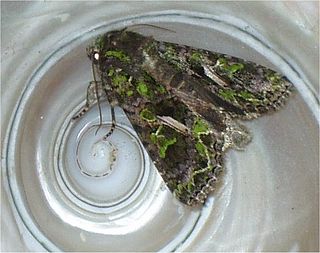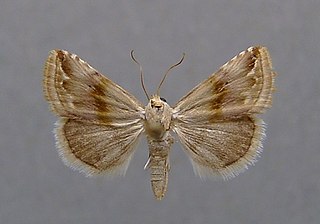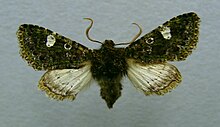
The dot moth is a moth of the family Noctuidae. The species was first described by Carl Linnaeus in 1761. It is a very distinctive species with very dark brown, almost black, forewings marked with a large white stigma from which the species gets its common name. The hindwings are grey with a dark band at the termen. The wingspan is 38–50 mm. It flies at night in July and August and is attracted to light, sugar and flowers.

The common Quaker is a moth of the family Noctuidae first described by Johan Christian Fabricius in 1775. Some authors prefer the synonym Orthosia stabilis(Denis & Schiffermüller, 1775). It is distributed throughout Europe and is also found in Turkey, Israel, Transcaucasia, Russia and eastern Siberia.

The angle shades is a moth of the family Noctuidae. The species was first described by Carl Linnaeus in his 1758 10th edition of Systema Naturae. It is distributed throughout Europe as far east as the Urals and also in the Azores, in Algeria, and in Asia Minor, Armenia, and Syria. It is strongly migratory.

Orthosia incerta, the clouded drab, is a species of moth of the family Noctuidae, found in Europe and Asia. The occurrence of the species extends through all European countries through the Palearctic to the Russian Far East and Japan. It is absent from northern Fennoscandia and in the Alps it occurs up to 2000 m above sea level.

Pyrrhia umbra, the bordered sallow, is a moth of the family Noctuidae. The species was first described by Johann Siegfried Hufnagel in 1766. It is found in all of Europe, east through Anatolia to Iran, Afghanistan, Pakistan and Nepal and through central Asia to Japan. In mountains it can be found up to elevations of 1,600 meters.

The Orache Moth(Trachea atriplicis) is a species of moth of the family Noctuidae. It is found in all of Europe, east across the Palearctic to the Pacific Ocean and Japan.

Xanthia togata, the pink-barred sallow, is a species of moth of the family Noctuidae. It is a Holarctic species, and is found throughout Europe and east through the Palearctic to Central Asia, and Siberia up to the Ussuri. The distribution area includes the United States and Canada. It was first described by the German entomologist Eugenius Johann Christoph Esper in 1788 from the type specimen in Germany

Allophyes oxyacanthae, the green-brindled crescent, is a moth of the family Noctuidae, found in Europe. The species was described by Carl Linnaeus in his landmark 1758 10th edition of Systema Naturae.

Conistra rubiginea, the dotted chestnut, is a moth of the family Noctuidae. The species was first described by Michael Denis and Ignaz Schiffermüller in 1775. It is distributed in Europe and, according to William Warren, Armenia and Asia Minor.

Agrochola macilenta, the yellow-line Quaker, is a moth of the family Noctuidae. The species was first described by Jacob Hübner in 1809. It is found in Europe and in Asia Minor.

Catocala electa, the rosy underwing, is a moth of the family Erebidae. The species was first described by Karl Friedrich Vieweg in 1790. It can be found in Europe and Asia.

Epilecta linogrisea is a moth of the family Noctuidae. It is found in Central and Southern Europe, Algeria, Morocco, the Caucasus, Armenia, Turkey, North-Western Iran, Syria, Israel and Lebanon.

Dasypolia templi, the brindled ochre, is a moth of the family Noctuidae. The species was first described by Carl Peter Thunberg in 1792. It is found in northern Europe up to central Siberia and more to the south in mountainous areas.

Agrochola helvola, the flounced chestnut, is a moth of the family Noctuidae. It was first described by Carl Linnaeus in his landmark 1758 10th edition of Systema Naturae. The species is found in most of Europe, north to Scotland and Fennoscandia up to the Arctic Circle, south to Spain, Sicily, Greece further east to the Middle East, Armenia, Asia Minor, western Turkestan and central Asia up to central Siberia.

Pyrrhia victorina is a moth of the family Noctuidae. It is found in Bulgaria, Greece, Romania, Slovenia, former Yugoslavia and Daghestan.

Jodia croceago, the orange upperwing, is a moth of the family Noctuidae. The species was first described by Michael Denis and Ignaz Schiffermüller in 1775. It is found in southern and central Europe, to the north up to the southern half of England and Wales. According to Warren. W. in Seitz, A. Ed., 1914 also in Algeria, Asia Minor, and Armenia.

Orthosia gracilis, the powdered Quaker, is a moth of the family Noctuidae. It is found in all of Europe except the extreme north and south, then east across the Palearctic to Northern Asia and Central Asia. O. g. pallidior is described from Xinjiang in China.

Nycteola revayana, the oak nycteoline, is a moth of the family Nolidae. The species was first described by Giovanni Antonio Scopoli in 1772. It is found from Europe and east across the Palearctic to Japan and India.

Eublemma ostrina, the purple marbled, is a moth of the family Erebidae. The species was first described by Jacob Hübner in 1808. It is mainly found in central and southern Europe, and further east, but is also a scarce migrant in the United Kingdom, where it is mainly found along the south coast.

Callopistria latreillei, Latreille's Latin, is a moth of the family Noctuidae. The species can be found in the Palearctic realm, most parts of Europe, Asia, and in Africa from Egypt to South Africa. The habitat consists of rocky limestone slopes with deciduous woodland.




















